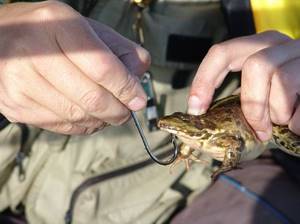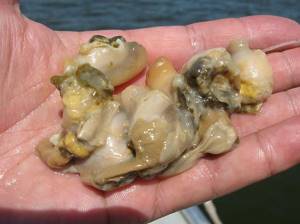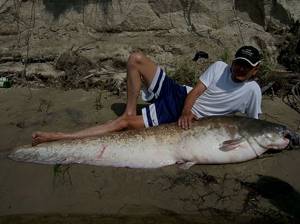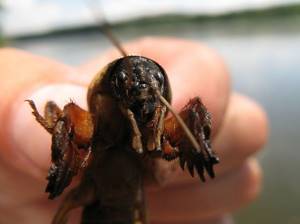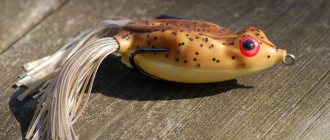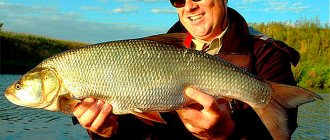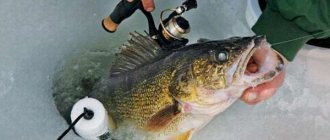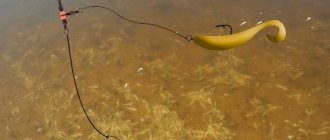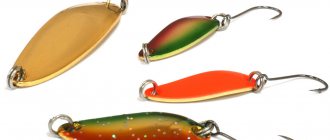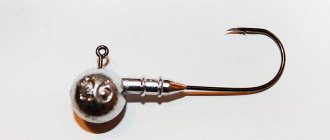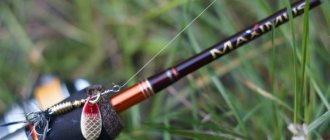Yuri 09/15/2020 498
As a rule, catching catfish with a frog occurs from spring to autumn. This is due to the fact that in winter it will be simply impossible to find such a nozzle. Frogs belong to the class of amphibians and come in two types: land amphibians and water-dwelling ones. Each of these species winters in different places, but is equally inaccessible to catfish fishing in winter.
This article will talk about catching catfish using land frogs, which are most often chosen for bait. These include: the grass frog and the sharp-faced frog, which is also called the swamp frog. With the onset of cold autumn days, they begin to look for secluded places for wintering: old tree hollows, rotten stumps, rodent holes, holes with last year's leaves. That is why finding such bait in winter under the snow is not only difficult, but not possible.
Where to fish and how to prepare
It is most effective to catch catfish using bottom fishing methods, using girders or classic corded bottoms. A fish such as catfish leads a bottom-dwelling, sedentary lifestyle, practically never leaving its usual habitat throughout the entire period of its existence. Whiskered predators prefer deep holes and ditches, looking for submerged snags, tree trunks, abandoned building structures and sunken boats for shelter. The predator likes to settle in backwaters, at the boundaries of mixing water currents of different strengths with access to shallows, where it regularly visits to feed at night.
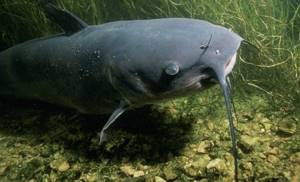
Using a frog as live bait, catfish are caught on stationary girders installed from the banks at promising fish exit points or on corded bottoms, which are mounted on flat underwater plateaus connected closely by pits located in the waters of the reservoir. These weapons are mostly used for hunting in the dark. Fishing with quok is carried out during daylight hours. This method requires a boat, which is floated along a trajectory directly above the predator’s parking areas, pits and underwater ditches.
Fishing begins from the moment of mass release of amphibians, approximately from the second half of May until the beginning of the autumn cold, when tree frogs begin to hide and go into suspended animation. For bait, large specimens weighing from 80-100 grams with bright colors and active behavior are selected. Although among fishermen there is no consensus about the mandatory survivability of the bait, because some fishermen specifically kill the bait, leaving it in the heat until signs of spoilage appear, or even lightly frying the frogs. On most rivers, catfish are more effectively caught using live bait.
About catfish, frogs and worms
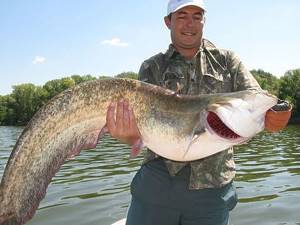
The last two of the listed methods are clearly out of the list, since they involve fishing with artificial bait.
But everything else is bait of animal origin. It is about the bait for catfish that I would like to speculate, because not everything is so simple.
Not a "princess" at all
Let's take such a common bait for catfish as a frog. It is this that is most often associated by fishermen as bait for catfish. I used this amphibious animal quite often as bait. I loaded the baits with them, tried to catch them with donks and seduce the mustachioed ones when quoting.
My observations are that not every frog is to the taste of catfish. We held green frogs in high esteem, not brown toads. We baited the latter when there was no other bait, because it is somehow not advisable to leave the hooks empty at night. So, I don’t remember a time when we caught a catfish using a brown toad. And although these toads often stand out for their size, that is not the point. Catfish are more willing to eat a green frog than a brown one. I do not know why. I just have these statistics accumulated.
Read the material “Soft baits for “hard” pike perch”
It’s clear that you walk with a flashlight at night, shine the light in the faces of the “princesses” so as not to accidentally step on an arrow, and grab everyone without hesitation. But first you use exclusively green ones as bait, because each tackle has its own most catchy hooks. Some are better suited in size, others in height in the water column, etc. But that's not all.
How, you ask, to impale this very frog? For a paw? And again, I cannot answer unequivocally.
We all know that amphibious creatures need air. Underwater, the frog will quickly die. It will “glue its flippers together” even faster; if the wound also bleeds, the frog will quickly become exhausted and hang on the hook with a piece of green skin. It is useless to turn it over, the “princess” will not come to life, I have failed many times...
Whether he will bite on such a catfish or will he look for something more appetizing is the big question. I am sure that catfish are more likely to bite on live bait. For this reason, I often hook frogs by piercing both lips. In this position, the frog swears less and moves its flippers longer, teasing the mustachioed frog.
|
| With this method of baiting the frog lives longer. Photo: Alexey Kolomiets. |
And all the same, if we talk about fishing with donks or nets, I would use frogs only if I am going to check these very tackles quite often and, if necessary, add fresh fish.
If you set the tackle, say, overnight, the frog will definitely die by morning. But if you fish with a quok, then a frog is quite suitable! After all, after swimming through the hole, the tackle is taken out of the water, the frog begins to breathe air and is grabbed again for the second swim, then for the third. Well, one more thing to say about frogs is that storing them is quite problematic.
Read the material “Boat on the water!”
Here on the Volga and Akhtuba below the Volzhskaya HPP the water level often changes. If you leave caught frogs in an iron cage on the shore, if the level rises, they will drown, and if the level drops, they will cook in the sun. They need constant monitoring, because catching them is a tedious task. They still strive to jump out of your hands or out of the cage.
The most comfortable nozzle
When catching catfish using kwok, I most often use the meat of toothless shells.
|
| The entire hook must be covered with shell meat. Photo: Alexey Kolomiets. |
There are many reasons for this. Shells are often easier to get. I immediately filled a bucket and it was done. If you want, immediately polish your meat so as not to get dirty in the boat. If you want, carry it in a bucket in the sinks.
They live well underwater. Flood the fishpond and sleep peacefully. To use fresh meat or something that has already been touched by the smell - opinions among my familiar fellows were divided approximately 50/50. At the same time, both of them catch catfish.
|
| Pavel fishes exclusively for toothless fish. Photo: Alexey Kolomiets. |
Personally, I prefer to constantly place a couple of fresh pieces on the hook with saggy meat. Still, I am a supporter of fresh food. But this is all about fishing with quok.
Read the material “Quicking Technique”
I would still put in fresh fish or, as a last resort, pieces of fish. It seems to me that the shell meat is quickly washed away by the current, it loses its smell and attractiveness. The fish pieces last longer, I think.
Therefore, if somewhere in the Astrakhan region we catch catfish on half-bottoms from a boat, we can also put a shell on it. Not a catfish, but a carp will bite. And if the tackle takes a long time to charge, then the shell is no longer a favorite in baits.
A few words about ringed
It's no secret that worms are a delicacy for almost all fish. Catfish is no exception. Often large crawlers are caught specifically for catfish. Because the hooks used are large and powerful. It is problematic to attach an ordinary earthworm to such a hook.
It must also be said that in different latitudes things are different with crawling. Here on the lower Volga it is very problematic to obtain them in quantity. You can buy it, but, again, in sufficient quantity it is either expensive or still not enough for fishing.
As an alternative to worms, you can consider using medicinal leeches. Those who have already fulfilled their medical purpose for a person. Leeches hold on to the hook very tightly. Even after idle bites, the leeches manage to hold on to the hook almost with their teeth. Of course, I'm being sarcastic, but leeches are a very strong bait.
About fish as bait
It’s clear that when catching a predator on donkeys, they most often use fry or the so-called “cutting” (pieces of fish). Generally speaking, when there are a lot of hooks on the tackle, then they plant everything that is at hand. Whatever comes across, will come across.
Pike perch, catfish, pike or even something red-listed - for all predators, whitebait remains the number one bait. But when it comes to catfishing specifically, I've heard that the best bait is perch.
My practice of catching catfish using bait confirms this. Perch lives on a hook longer than other fish. He can swim with a huge hook in his back for several days! My observations are echoed by old people who spent more time on the Volga than I did. They can talk about fried sparrows, mole crickets, and locusts, but most often they point to perch. Like, perch is the best, but how to catch it!
Read the material “The mysterious screamer of the meadows - the corncrake”
And here we, young fishermen with fashionable ultralight gear, begin to smile widely. Perch is not a problem! I once heard someone say that the best bait for catfish is an asp with the meat turned outward. I fully admit this. Asp is a fatty fish and will smell more in the water than its “inverted” relatives in the order or family.
I can only list other baits of animal origin that I have heard of: crayfish, mole crickets, locusts, cockchafer larvae. I tried to plant them, but somehow it didn’t work out.
|
| Medvedka, front view. Photo: Alexey Kolomiets. |
I have very little statistics, so I will be glad if someone shares their observations on this matter.
Well, I have listed my main baits when catching catfish. I hope someone finds this interesting.
Alexey Kolomiets September 24, 2021 at 10:32 am
How to catch and where to get a frog
The search for suitable bait should be done in the coastal zone of the fished reservoir. Tree frogs love to inhabit coastal areas densely overgrown with aquatic vegetation with areas of shading and shallow depths.
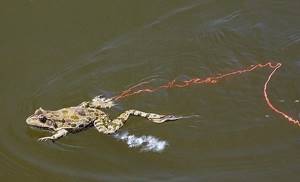
Important! Duckweed on the water is a sure sign that amphibians live in these waters.
Catching frogs can be done in several ways. The easiest way is to collect live bait with your bare hands. To do this, the fisherman will need a certain skill and attentiveness required to track and catch live bait. It’s easier to catch baby frogs with a net, which can be done both in the water and by looking for specimens suitable for bait right on the shore. For fishing, you can use a fishing rod equipped with a fishing line and a small hook. A piece of a worm, maggot, fly or any other insect living near a reservoir is placed on the hook and placed directly under the nose of a potential bait spotted in the water. The frog rushes to the bait and becomes easy prey for the fisherman.
If fishing is carried out over several days, you can use the time-tested method of collecting amphibians. For these purposes, in the evening, they dig a small hole, half a meter deep, near the shore, covering its bottom with fresh grass. During the night, the frogs will gather in an improvised trap, and in the morning the fisherman will have to select specimens suitable in size for bait, guaranteed to continue fishing.
What to catch?
Catfish are not vegetarian, therefore, first of all, when going fishing for this particular type of fish, you should stock up on bait of animal origin.
Of the animal baits, catfish like the following baits the most:
Frog
Large individuals willingly eat this delicacy. Catching a predator with a live frog can be effective both during the day and at night. A live frog is attached to a single hook by the lip or hind leg. With this method of baiting, the bait remains alive for a long time and attracts predators by underwater throwing from side to side.
Medvedka
This is a favorite treat for small catfish weighing up to 5 kg. This insect moves very actively and attracts fish immediately after it appears in the water. Catfish do not have acute vision, but their lateral line receptors are well developed, so when such “dancing” food appears, bites occur almost instantly.
The bear is attached to a double hook; punctures of the body are made from below, one in the abdomen area, the second behind the head. If you plan to catch a large catfish, then you can use a large single hook, onto which you attach 3 to 5 mole crickets.
Zywiec
Fishing with live fish can be effective at night. To catch trophy catfish, the size of the live bait must also be significant. Most often, carp fish weighing up to 500 grams are used. The live bait is attached to the dorsal fin with a tee so that the fish can actively move under water for a long time and attract a predator.
Where and how long can you store a frog?
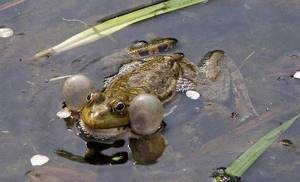
Frogs cannot be classified as bait that has a long shelf life. An amphibian, once in captivity, quickly loses its activity and attractive color. This is caused not only by the stress of being caught, but also by the fact that frogs are quite voracious in nature, constantly hunting and feeding heavily, thereby maintaining a high degree of activity.
Catfish are reluctant to bite on a passive frog, and only during periods of high feeding activity can positive results be expected. These conditions force the fisherman to constantly stock up on fresh live bait, keeping it in captivity for no more than half a day. The attractiveness of live bait, even in this short period of time, can be achieved by placing amphibians in a voluminous plastic container with a lid. The bottom of the container is covered with grass and a little water is added, creating a level of about 5-7 cm. Water must be taken from the reservoir where the live bait was caught, trying to replace it every 2-3 hours. Cana with live bait are stored in a cool, shaded place from the sun.
How to bait a frog
There are two main ways to bait live bait. Moreover, both of these options do not hinder the natural movements of the amphibian and allow it to maintain its viability for a long time. I would like to immediately draw your attention to the fact that for installing frogs into a rig, a hook with a long shank is required. The simplest and fairly easy way of baiting is considered to be a through puncture of live bait into the thigh of the hind leg. This method does not cause serious damage to live bait and does not hinder its movements.
The second method is inherent to already experienced somyatniks. The technique involves mounting the tree frog behind the skin of the back. This requires caution and skill in baiting, since due to inexperience, damaging the animal’s spine can completely immobilize it, thereby depriving the bait of its attractiveness to a predator. If the fishing strategy involves fishing with a dead bait, the most practical and effective way is to mount the amphibian by piercing the hook through the mouth.
Technique for catching catfish with a frog
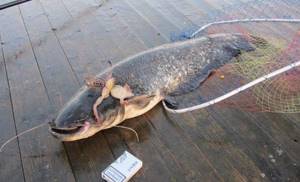
Catching catfish from the shore with a frog is carried out on stationary girders or so-called hangers, installed by attaching bushes, tree branches or specially prepared poles hanging over the promising fishing point, which are stuck into the shore or bottom of the reservoir. Depending on the activity of the predator, bait is placed both at the very bottom of the reservoir and in the water column, determining the horizons that are promising for bites.
The technique of fishing with girders brings the best results in the dark, when catfish approach the coastlines to feed, leaving their main shelters located in water areas more distant from the coast. Kwok is more effective during the day. Fishing is carried out using a line tackle held by the fisherman in his hands with simultaneous nodding, that is, attracting fish with a peculiar sound to the fishing zone attached to the hook of the bait. Baiting is carried out at the speed of the current, floating on a boat above the hole, delivering the bait to the middle horizons of the water. For the convenience of fishing these days, many fishermen use an echo sounder, which tracks not only changes in bottom topography, but also gives the fisherman information about the presence of an active predator in the hunting zone, rising from the depths to the sound of a quok and bait bait that attracts it.
The nuance of fishing for amphibians, regardless of the fishing method, is the fact that the amphibian, due to its physiological characteristics, can stay under water for no more than half an hour. Otherwise, the live bait suffocates and becomes of little interest to the predator.
Important! To ensure the duration of use of the bait, it is recommended to take out the live bait after half an hour of fishing, allowing it to catch its breath for at least 5-10 minutes, after which you can safely return the rig to the fishing point.
This technique allows one specimen of live bait to be fished for 10-12 hours, after which the frog is replaced with fresher material.
Tackle for catfish
Short and very strong fishing rods are used as gear for catching catfish. The length of such rods does not exceed two meters; it is better to use one and a half meter rods. For large catfish, you can use sea rods.
It is better to use powerful multipliers as a reel. Although you can use ordinary inertial reels (Neva) and inertialess carp reels.
The fishing line used is monofilament or braided, with a diameter of 0.4-0.6 mm. With a reserve of 100 meters.
Use steel or titanium leashes. The small teeth of a catfish can easily grind both monofilament and braided fishing line.
The hook on the leash should be very large and sharp.
A good hook should not break under load, but bend.
It is very important to correctly tie the hook to the fishing line and glue the knot; the fishing line in the knot should lie turn to turn.
fisher-book.ru
Fishing
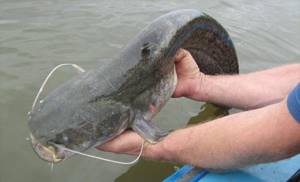
For the most part, the tackle for catching catfish with a frog is a purely corded device, used in practice without a rod. Fishing for often quite heavy fish has a number of features related to ensuring the safety of the fisherman himself, whether fishing from the shore, or even more so from a boat. It’s safer to go on catfish fishing trips with a companion who can provide backup in case of unusual situations, which is a very common thing when fighting large catfish. After feeling the bite, they make a sharp hook, detecting the fish, and then begin to lift it from the depths. The cord is constantly kept under tension, preventing the fish from moving into cover and tangling the tackle.
Important! Do not wrap the cord of the tackle around your hand in any way. A large catfish, as a result of a struggle, can easily pull even a massive fisherman into the water.
When tiring the fish, they try to give it as little free line as possible. The proximity of the end of the fight is noticeable by air bubbles beginning to rise to the surface of the water, signaling that the catfish is exhausted from the fight and will soon be brought to the surface of the water. After rising to the surface, the predator is purged, and small specimens are picked up in a landing net. To be sure, when fishing, a fisherman should have a humanizer, which is used to stun the trophy and after that they put it on the kukan, securely tying the device to a tree or other massive object, releasing the prey to the shallows.
Equipment for catching catfish
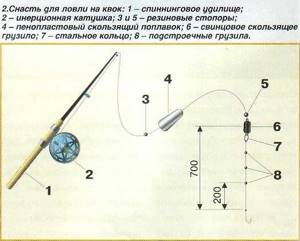
For any tackle, a frog will be a good bait option, and there should not be any particular difficulties in catching and using it. Don’t forget to take a hook or a large landing net with you when fishing, because catfish sometimes reach enormous sizes and are distinguished by considerable physical strength, and therefore are able to resist for a long time.
Author of the article: Vitaly Leonidovich Ivanov, 2021.
